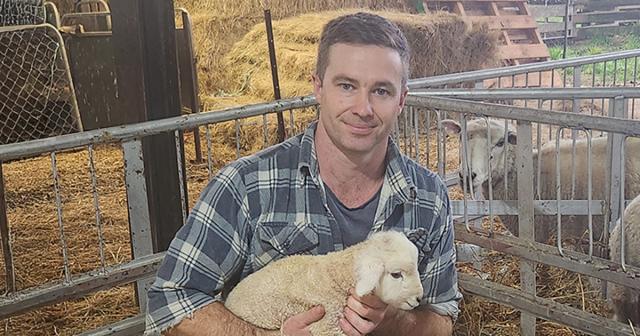On a cold, wet July day, 200 single or triplet-bearing ewes were tucked up in the Dawkins family’s warm, dry lambing shed waiting on the impending arrival of their lambs.

This is the eighth year that Marlborough farmers Chris and Richard Dawkins have run an indoor lambing system in a bid to minimise lamb and ewe wastage, particularly in their triplets – and it’s working.
They have reduced farm-wide losses between scanning and weaning from a long-term average of 24% down to around 15% and continue to tweak what is a simple indoor lambing system even further to minimise both costs and losses.
Concerned about both the financial and animal welfare implication of lamb wastage, particularly in their triplet lambs, Chris and Richard set up the indoor lambing system in 2017, as part of Beef + Lamb New Zealand Innovation Farm programme.
Drawing on the experiences of other farmers and the expertise made available to them through the programme, the father and son team set out to develop a system which saw them transition triplet ewes into the indoor shed where they lambed.
When B+LNZ visited the Dawkins at the end of July this year, the family had 200 ewes in the shed. This was maximum number of ewes they would have indoors at any one time, all identified as being either single or triplet-bearing. They also had a ram harness mark, with the raddles changed every six days through mating, indicating when they were due to lamb.
The at-drop ewes are held in pens with deep straw bedding, and fresh straw is laid down daily. While in the shed, the ewes have ad-lib access to lucerne hay and are fed peas several times throughout the day. Richard says peas are a low-cost, high-protein feed that the ewes find very palatable.
After a ewe has lambed, she is removed from the other ewes and, along with her lambs, is put into a “bonding pen” by herself until the lambs are fully bonded and are strong enough to be moved outside.
Richard says this process not only protects the lambs from adverse weather, it also ensures assistance is given if required during lambing, and the ewes' milking ability is checked over the following days. The ewes typically spend five to seven days indoors.
After years of running the lambing shed themselves, last year the family employed lambing shepherd Laura Inglis and her ability to mother-on lambs has virtually eliminated orphan lambs.
Richard says they did buy an automatic lamb feeder a few years ago, but it is now completely redundant, thanks to Laura's technique of mothering orphans onto singles.
When conveniently timed, Laura will physically lamb single-bearing ewes and in the process, add a struggling triplet lamb to the birth fluids, so when the ewe gets up, she has two lambs to take care of – and she is none the wiser!
Refining the system
In 2017, when the family first set up the indoor system they followed “by the book” best-practice. This included feeding the triplet-bearing ewes supplement three weeks out from lambing, changing the straw in the lambing shed frequently, using disinfectant and iodine and continuing to feed supplement one week after lambing.
The following year, they refined the system and only fed the ewes supplement five days out from lambing and fed peas and lucerne hay instead of more expensive chaff. They put fresh straw on top of the old straw and stopped using disinfectant and iodine. They didn’t feed supplements to the ewes after lambing.
These efficiency gains saved time and money without compromising the health or survival rate of the ewes and lambs.
Richard says while they are confident that they have greatly reduced preventable deaths, the lambing percentage of the entire triplet mob, from birth to weaning, has ranged from 220% to 248%.
The most common cause of death is abortion or stillbirth, most of which must occur soon after scanning.
Ewe deaths have dropped from a long-term average of 10% to 1–2%. The savings from ewes alone covers the cost of the system
They do believe they can do this so effectively because their shed captures a lot of morning sun, is very well ventilated and Marlborough’s relatively kind climate makes for a healthy environment for the ewes and lambs.
After lambing
Once the Dawkins are sure the ewes and lambs have bonded, and the lambs are drinking well, they are run out onto high quality annual ryegrass pastures or lucerne.
In the first few years they would monitor the triplet sets in the paddock closely, looking for lambs falling behind. However, with the new mothering system, any lambs that are not guaranteed to thrive on their mother are removed and mothered on to a single. This reduced post-shed paddock death rates to just 5/162 lambs (3%) in full triplet sets this year.
Through August, the complete triplet sets are run onto pure annual ryegrass stands, with covers of 2000 kg DM/ha. Later in lactation, once covers and quality have diminished, they are moved onto pure lucerne stands. This allows the composite ewes to express their genetic potential, which drives triplet lamb growth rates of around 350g/day over the 105-day lactation period
In 2024, the triplet mob averaged 41.0kg with 93% sold prime off mum, and a 285% lambing percentage.
“This was very rewarding. We believe there has been too much focus on high scanning percentages in the past and the number of lambs alive at weaning should be the real target”, says Richard.